Pdo Feta Cheese Market Research, 2033
The global pdo feta cheese market size was valued at $343.2 million in 2023 and is projected to reach $662.3 million by 2033, growing at a CAGR of 6.8% from 2024 to 2033.
The pdo feta cheese market growth is primarily driven by factors such as an increase in consumer demand for authentic and high-quality cheese products, a rise in the popularity of Mediterranean cuisine, expansion of retail and food service sectors, and the rise in awareness and preference for PDO-designated products, which ensures authenticity and quality to consumers worldwide.
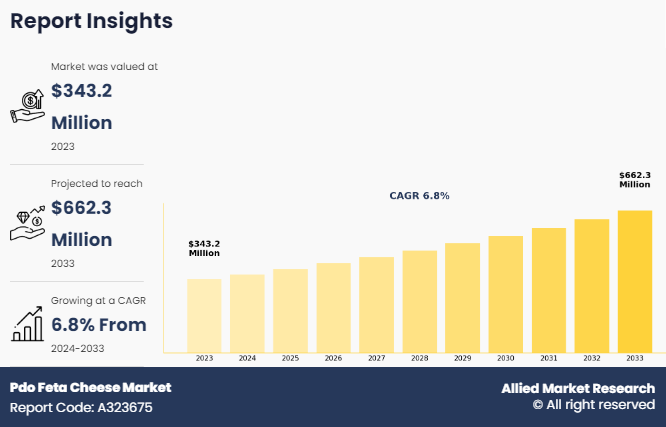
Market Dynamics
PDO feta cheese refers to feta cheese that has been certified with a Protected Designation of Origin (PDO) status by the European Union. The certification guarantees that the cheese is produced, processed, and prepared in specific regions of Greece according to traditional methods and strict quality standards. PDO feta cheese is made from sheep's milk or a blend of sheep's and goat's milk, which ensures its unique flavor and high quality. The market for this cheese includes both the food service sector, such as restaurants and catering services, and retail outlets such as supermarkets and specialty food stores, where consumers seek authentic and high-quality feta cheese products.
Feta cheese is rich in essential nutrients, which significantly boosts the pdo feta cheese market demand . Feta cheese provides a high content of calcium, which is crucial for bone health, and is an excellent source of protein, that supports muscle maintenance and overall body function. Feta cheese is also lower in fat and calories compared to many other cheeses, which has made it a convenient option for those seeking healthier alternatives. In addition, the presence of essential vitamins in feta cheese, such as vitamin B12, crucial for red blood cell formation and neurological function, and phosphorus, vital for energy production and bone health, has driven the demand for pdo feta cheese in both the food service and retail sectors.
Furthermore, feta cheese contains probiotics, which promote gut health by supporting a balanced intestinal microbiota. The probiotic content helps in improving digestion and boosting the immune system, which has thus made it a preferred choice among health-conscious consumers. The presence of conjugated linoleic acid (CLA) in feta cheese has been associated with potential weight management benefits and anti-inflammatory properties, which has made feta cheese a popular option among individuals on weight loss diet. These health benefits, combined with the assurance of quality and authenticity provided by the PDO label, have significantly boosted the demand for feta cheese in both the food service and retail markets, as consumers increasingly prioritize health in their dietary choices.
However, the limited availability of PDO-certified milk poses a significant restraint on the market demand for pdo feta cheese. PDO certification requires strict adherence to traditional production methods and the use of milk from specific regions, which can lead to supply constraints. The restricted availability of PDO-certified milk restricts the production capacity of feta cheese producers, thus limiting the volume of PDO-certified feta cheese available in the market. As a result, retailers and food service providers may face challenges to meet consumer demand for authentic PDO feta cheese products.
In addition, the limited availability of PDO-certified milk can also impact the pricing of pdofeta cheese. With a constrained supply of certified milk, producers may incur higher costs to secure the necessary raw materials, which may lead to increased production expenses. These increased costs may ultimately be passed on to consumers in the form of higher prices for PDO-certified feta cheese products. As a result, price-sensitive consumers may opt for other cheese alternatives, which is anticipated to further reduce the market demand for PDO feta cheese in the retail and food service industry. Overall, the limited availability of PDO-certified milk presents a significant hurdle for the growth of the pdo feta cheese market.
The introduction of organic feta cheese has significantly created opportunities in the pdo feta cheese market. As consumers become more health-conscious and environmentally aware, the demand for organic products continues to rise. Organic feta cheese, produced without synthetic pesticides, fertilizers, or genetically modified organisms, appeals to these health-conscious consumers seeking cleaner, more natural food options. The shift toward organic consumption allows food service providers, such as restaurants and cafes, to diversify their menus with organic offerings, which helps attract a broader customer base that prioritizes sustainability and health.
In the retail sector, organic feta cheese has gained the attention of a growing segment of consumers willing to pay a premium for organic products, which has driven the pdo feta cheese market growth. According to the 2023 Organic Industry Survey by the Organic Trade Association, organic food sales in the U.S. in 2022 crossed $60 billion, which highlights the increase in demand for organic product in the U.S. market. The growth is expected to benefit PDO food service and retail organic PDO feta cheese by boosting consumer demand for organic products, leading to increased sales and market opportunities. The supermarkets and specialty stores can take advantage of the organic trend by expansion of their organic cheese selections, meeting the increase in demand for organic dairy products. The introduction of organic PDO feta cheese has created a competitive edge for retailers that can distinguish themselves by offering high-quality, organic feta cheese. Furthermore, the organic label can enhance brand perception, leading to increased consumer trust and loyalty. Thus, by entering into the organic market, producers and retailers meet current consumer demands and can position themselves as leaders in the sustainable and health-focused food industry.
Segmental Overview
The pdo feta cheese market size is segmented into source, packaging, application, distribution channel, and region. By source, the market is categorized into goat milk and sheep milk. By packaging, it is bifurcated into food service and retail. Further, the food service pdo feta cheese market is divided into 5lbs, 8lbs, and 10 lbs. and above, while retail pdo feta cheese market is divided into 150-200 gm, 400-500 gm, and 1kg and above. By application, it is classified into salads, pastries, sandwiches, pasta, meat, pizza, and others. By distribution channel, the market is divided into food service and retail. The food service distribution channel segment is further fragmented into full-service restaurants, fast food outlets, catering services, bakeries/pastries, and others, whereas the retail distribution channel segment is categorized as hypermarkets and supermarkets, specialty stores, online retail, and others. By region, it is analyzed across North America (the U.S., Canada, and Mexico), Europe (Germany, France, Italy, Spain, the UK, Greece, the Netherlands, Belgium, Denmark, and rest of Europe), Asia-Pacific (China, Japan, India, South Korea, Australia, Indonesia, Singapore, and rest of Asia-Pacific), and LAMEA (Brazil, South Africa, UAE, Argentina, Nigeria, Turkey, and rest of LAMEA).
By Source
By source, the goat milk segment dominated the global pdo feta cheese market share in 2023 and is anticipated to maintain its dominance during the forecast period. Traditionally PDO feta cheese was made with 30% goat's milk and 70% sheep's milk. Unlike others, feta cheese cannot be made with 100% goat milk, due to its high lactose content. Traditional goat's milk feta cheese contains a high level of phosphorus and calcium. Consumption of calcium and phosphorus helps in increasing bone density and preventing osteoporosis. A fatty acid called conjugated linoleic acid (CLA) is present in goat's milk feta cheese. CLA helps to improve body composition in the long term. Excessive salt in feta cheese prevents the customer from adding it to their daily diets, as it may cause high blood pressure and it is also one of the reasons why it is not as popular as sheep milk.
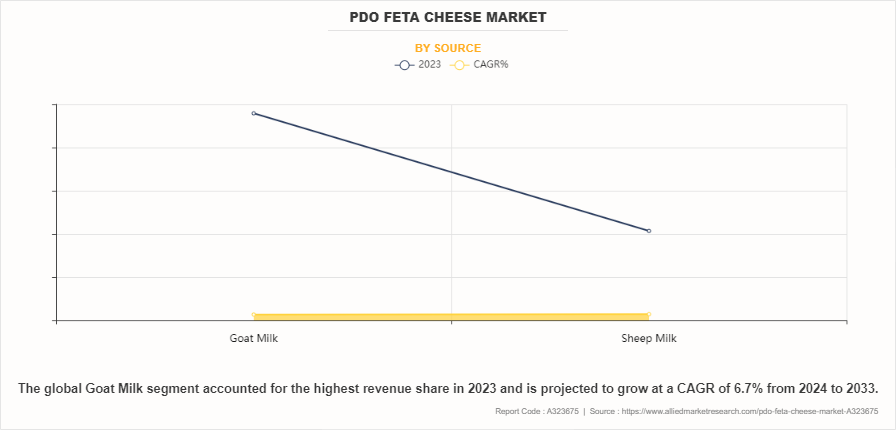
By Packaging
By packaging, the food service segment dominated the global pdo feta cheese market in 2023 and is anticipated to maintain its dominance during the pdo feta cheese market forecast. Streamlined packaging solutions such as portion-controlled packs or resealable containers not only minimize food waste but also optimize kitchen workflow by reducing preparation time and ensuring consistent portion sizes. Moreover, packaging innovations that prioritize durability and freshness preservation help extend the shelf life of PDO feta cheese, reducing the frequency of restocking and minimizing inventory management challenges for food service operators.
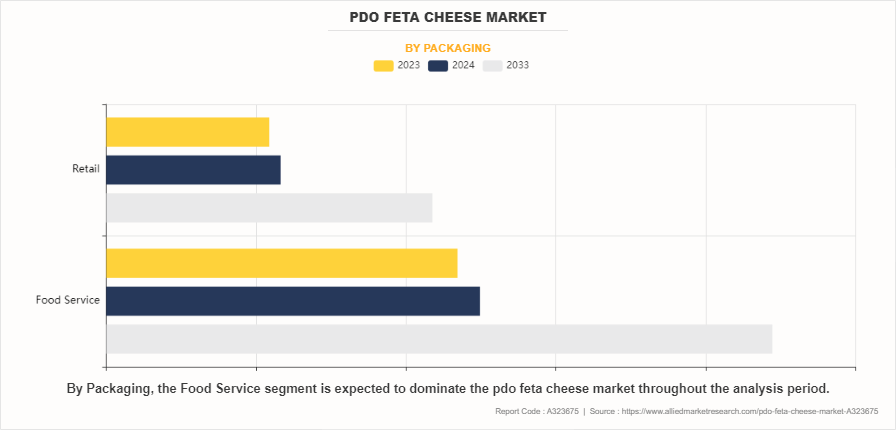
By Application
By application, the salads segment held a major pdo feta cheese market share in 2023 and is anticipated to maintain its dominance during the forecast period. Salads are beneficial for diabetic patients, and vegetable salads help to maintain a healthy weight. The increase in awareness about the benefits of salads in consumers is fueling the demand for PDO feta cheese usage in salads. The food service industry is concentrating on bringing innovative salads with high nutritional values as global consumers are shifting toward healthy eating habits. The influence of European food culture in the market is attracting global consumers to go for European cuisine. The restaurants & fast-food outlets in all the regions (except Europe) are adopting to offer Greek feta cheese salad along with their other recipes to capture the interest of the consumers and increase their sales. Additionally, the growing trend towards Mediterranean diets, which emphasize wholesome, natural food, further boosts the demand for PDO feta cheese in salads, making it a preferred choice for both everyday meals and gourmet dishes.
By Distribution Channel
By distribution channel, the food service segment dominated the global pdo feta cheese market in 2023 and is anticipated to maintain its dominance during the forecast period. The surge in demand for various fast food from the leading food chains such as Burger King, KFC, McDonalds, and Dominos is anticipated to boost the demand for PDO feta cheese through food service distribution channel. High consumption of pizzas, burgers, and pasta is the key factor that augments the growth of the pdo feta cheese market. Moreover, the players in the food industry usually spend 24% of their revenue on marketing, as the industry is extremely competitive with low customer loyalty. At the same time, this puts a lot of pressure on a food and beverages marketing agency to create a superior level of customer satisfaction with every interaction to keep customers from changing their preferences.
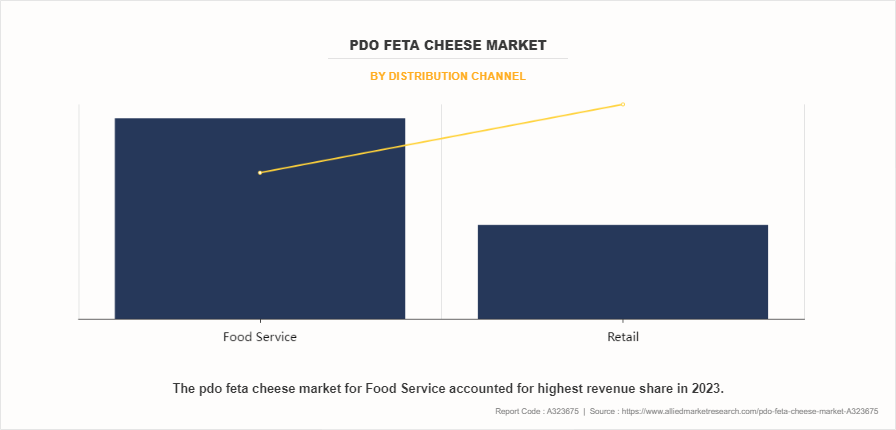
By Region
Region-wise, Europe is anticipated to dominate the pdo feta cheese market with the largest share during the forecast period. PDO feta cheese is primarily manufactured in Greece and exported from European countries to all over the world. Furthermore, the rise in popularity of European food culture is a major driver of the pdo feta cheese market's expansion. Immigrants also have a habit of bringing their culture with them wherever they go, which has a big impact on current cuisine culture. Germany and Greece have the largest feta cheese markets in Europe due to an increase in demand from millennials and an increase in desire for fresh and ready-to-eat food owing to change in lifestyles. In Germany, PDO feta cheese is in high demand because it is found in a lot of food stuff and is enjoyed by everyone, primarily health-conscious individuals. Moreover, the European PDO feta cheese industry is driven by increased awareness of the benefits of cheese, its low cost, and the expansion of application areas.
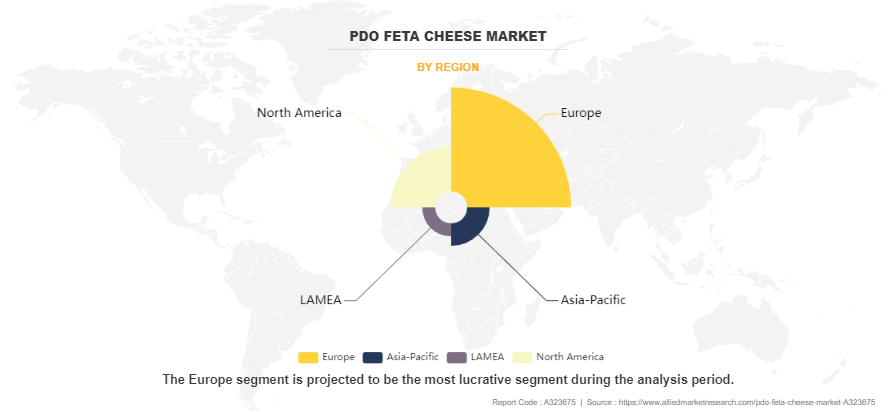
Competitive Analysis
The key players operating in the PDO feta cheese industry include Hotos SA, Kolios S.A. Greek Dairy, Dodoni S.A., Epirus S.A., Mevgal S.A., Olympus (Hellenic Dairies S.A.), Bizios Dairy, CHRISTAKIS S.A., Futura Foods, and INAXOS. Several well-known and upcoming brands are vying for market dominance in the expanding PDO feta cheese industry. Smaller, niche firms are more well-known for catering to consumer demands and preferences. Large conglomerates, however, control most of the market and often buy innovative start-ups to broaden their product lines.
Key Benefits For Stakeholders
- This report provides a quantitative analysis of the market segments, current trends, estimations, and dynamics of the pdo feta cheese market analysis from 2023 to 2033 to identify the prevailing pdo feta cheese market opportunities.
- The market research is offered along with information related to key drivers, restraints, and opportunities.
- Porter's five forces analysis highlights the potency of buyers and suppliers to enable stakeholders make profit-oriented business decisions and strengthen their supplier-buyer network.
- In-depth analysis of the pdo feta cheese market segmentation assists to determine the prevailing market opportunities.
- Major countries in each region are mapped according to their revenue contribution to the global market.
- Market player positioning facilitates benchmarking and provides a clear understanding of the present position of the market players.
- The report includes the analysis of the regional as well as global pdo feta cheese market trends, key players, market segments, application areas, and market growth strategies.
Pdo Feta Cheese Market Report Highlights
| Aspects | Details |
| Market Size By 2033 | USD 662.3 million |
| Growth Rate | CAGR of 6.8% |
| Forecast period | 2023 - 2033 |
| Report Pages | 516 |
| By Application |
|
| By Distribution Channel |
|
| By Source |
|
| By Packaging |
|
| By Region |
|
| Key Market Players | INAXOS, Epirus S.A., Kolios S.A., Mevgal S.A., Futura Foods, N. Th. Kouroushis Ltd, CHRISTAKIS S.A., DODONI S.A., Bizios Dairy, Hotos SA |
Analyst Review
CXOs believe that the growth of the PDO feta cheese market in both the food service and retail sectors is driven by several key factors. Firstly, they have highlighted that the increase in consumer demand for authentic and high-quality cheese products, coupled with the rise in popularity of Mediterranean cuisine, creates a favorable environment for the expansion of PDO feta cheese sales. CXOs also stated further that the versatility of feta cheese allows for its incorporation into a wide range of dishes, catering to diverse consumer preferences and thus driving market growth.
Moreover, CXOs believe that the emphasis on health and wellness among consumers contributes to the growth of the PDO feta cheese market, as it is perceived as a healthier option compared to other cheeses due to its lower fat content and higher protein levels. In addition, CXOs have highlighted the importance of strategic partnerships and collaborations with food service providers, retailers, and online platforms to enhance market reach and visibility. Overall, CXOs are optimistic about the growth prospects of the PDO feta cheese market in both the food service and retail sectors, citing factors such as consumer demand, product versatility, and health benefits as key drivers of market expansion.
The global pdo feta cheese market size was valued at USD 343.2 million in 2023, and is projected to reach USD 662.3 million by 2033.
The global pdo feta cheese market is projected to grow at a compound annual growth rate of 6.8% from 2024-2033 to reach USD 662.3 million by 2033.
The key players profiled in the reports includes Hotos SA, Kolios S.A. Greek Dairy, Dodoni S.A., Epirus S.A., Mevgal S.A., Olympus (Hellenic Dairies S.A.), Bizios Dairy, CHRISTAKIS S.A., Futura Foods, and INAXOS.
Europe dominated in 2023 and is projected to maintain its leading position throughout the forecast period.
Health Benefits and Nutritional Value, Authenticity and Quality Assurance, Health-Conscious and Sustainable Consumer Trends, Growth of Organic and Clean Label Trends, Growing Demand for Mediterranean Diet and Cuisine, Expansion in Food Service and Retail Sectors majorly contribute toward the growth of the market.
Loading Table Of Content...
Loading Research Methodology...



